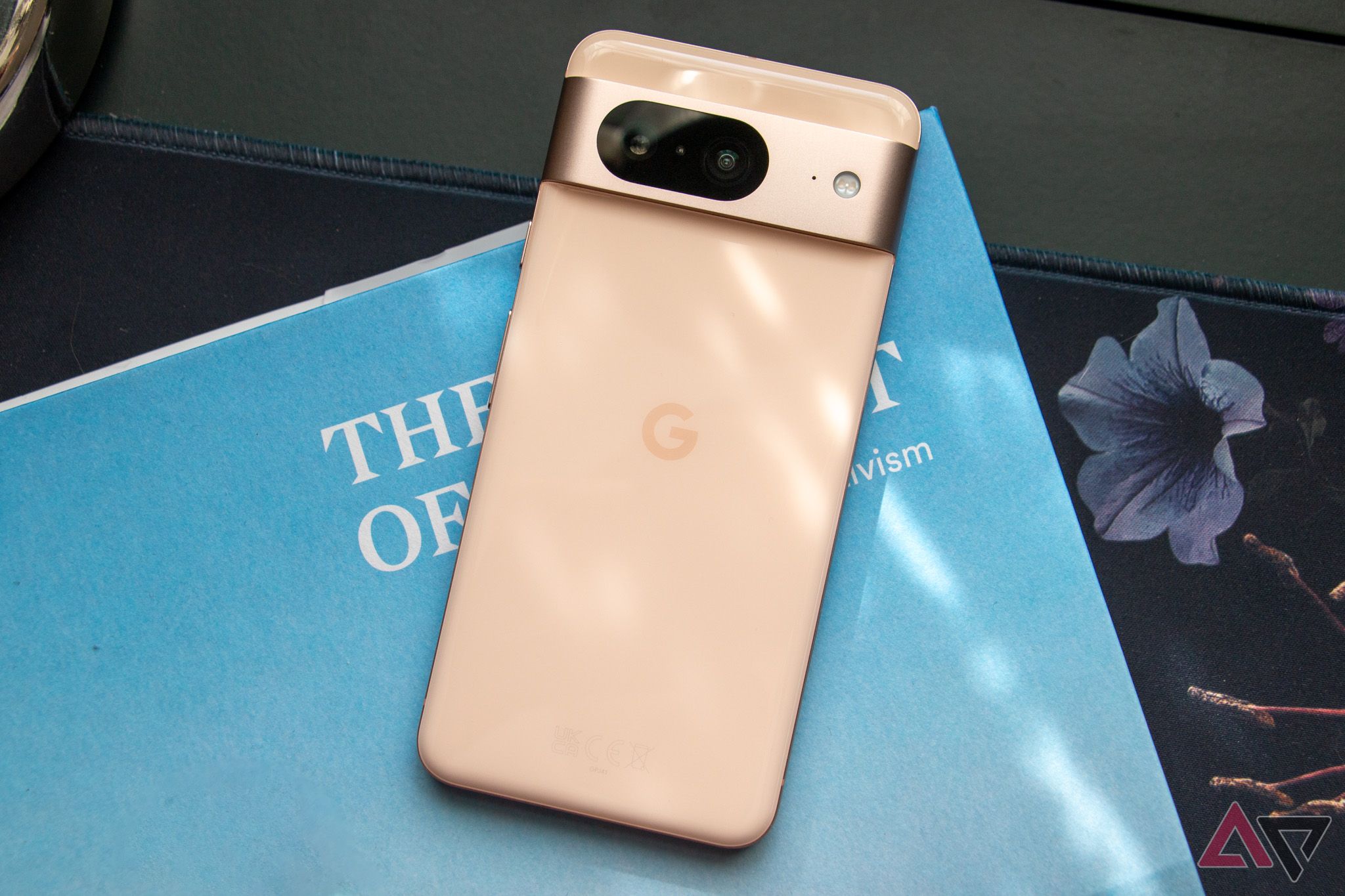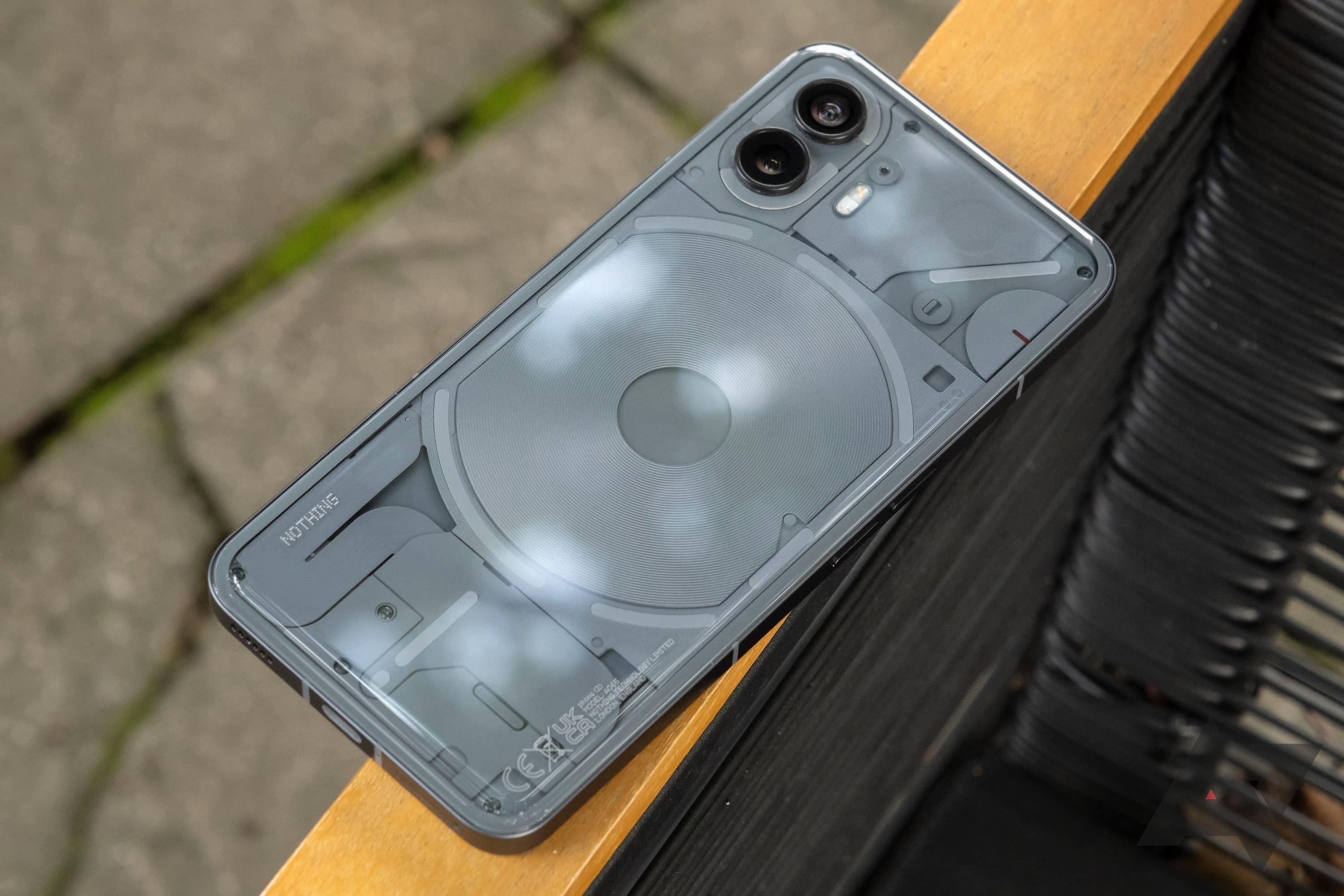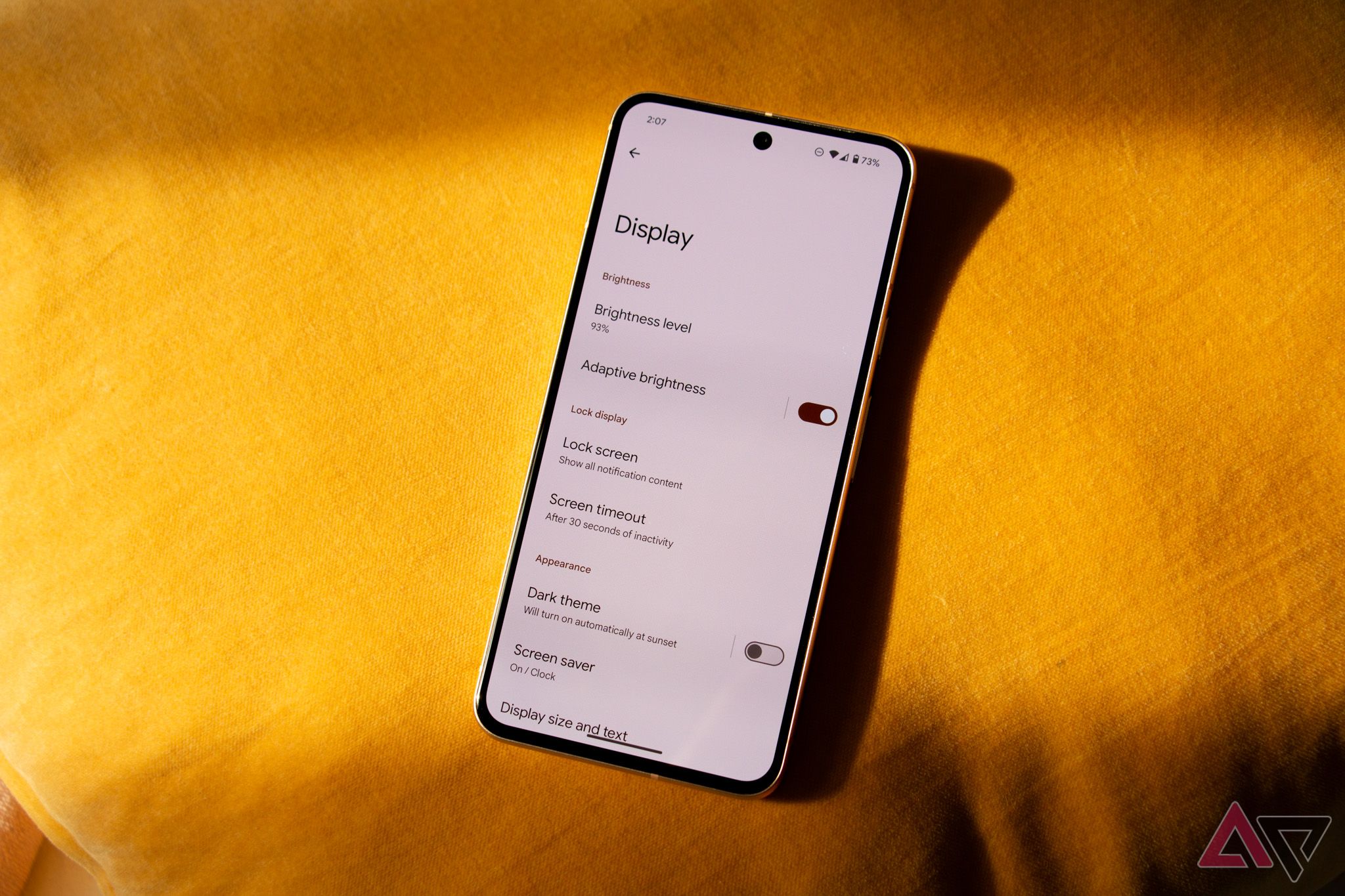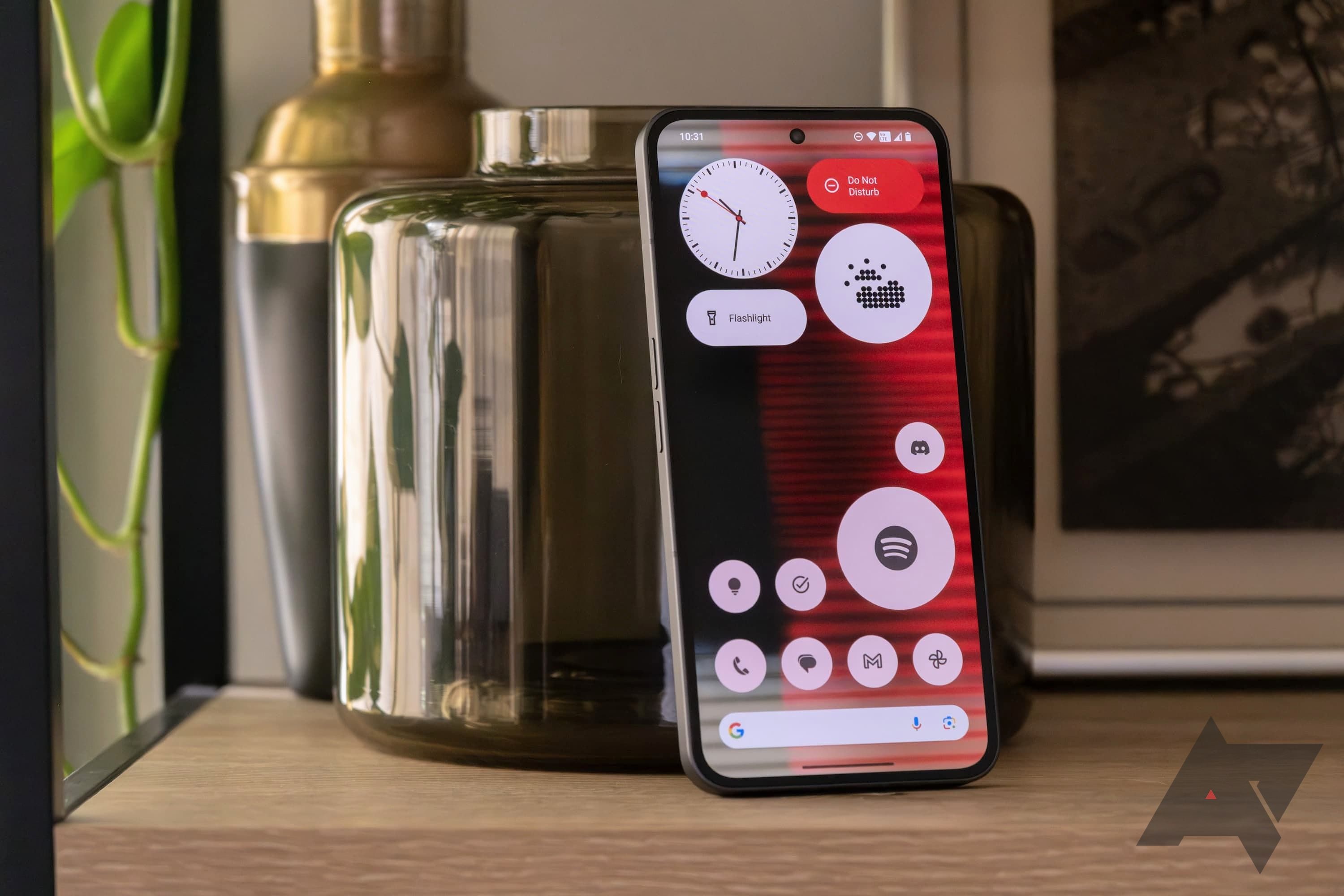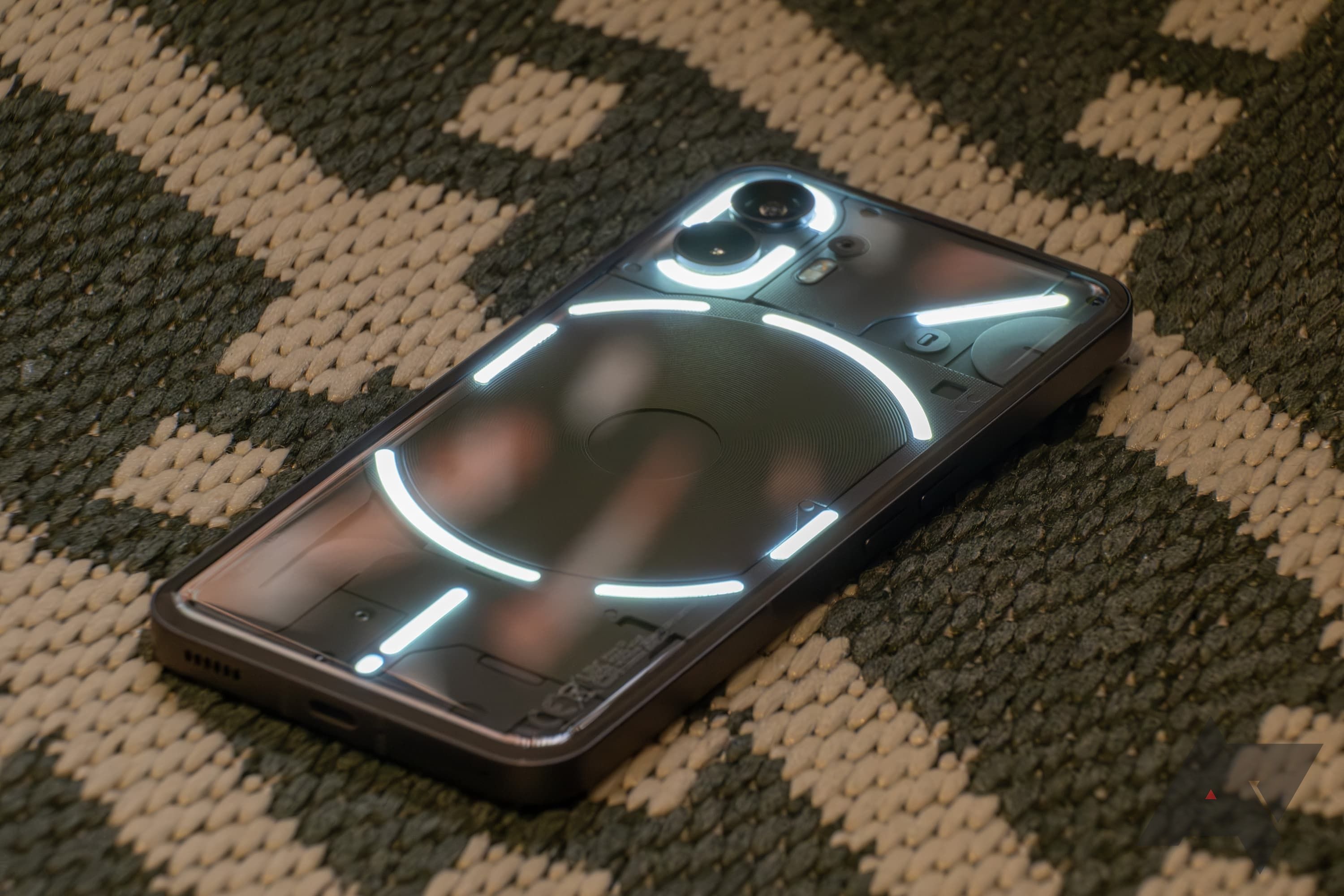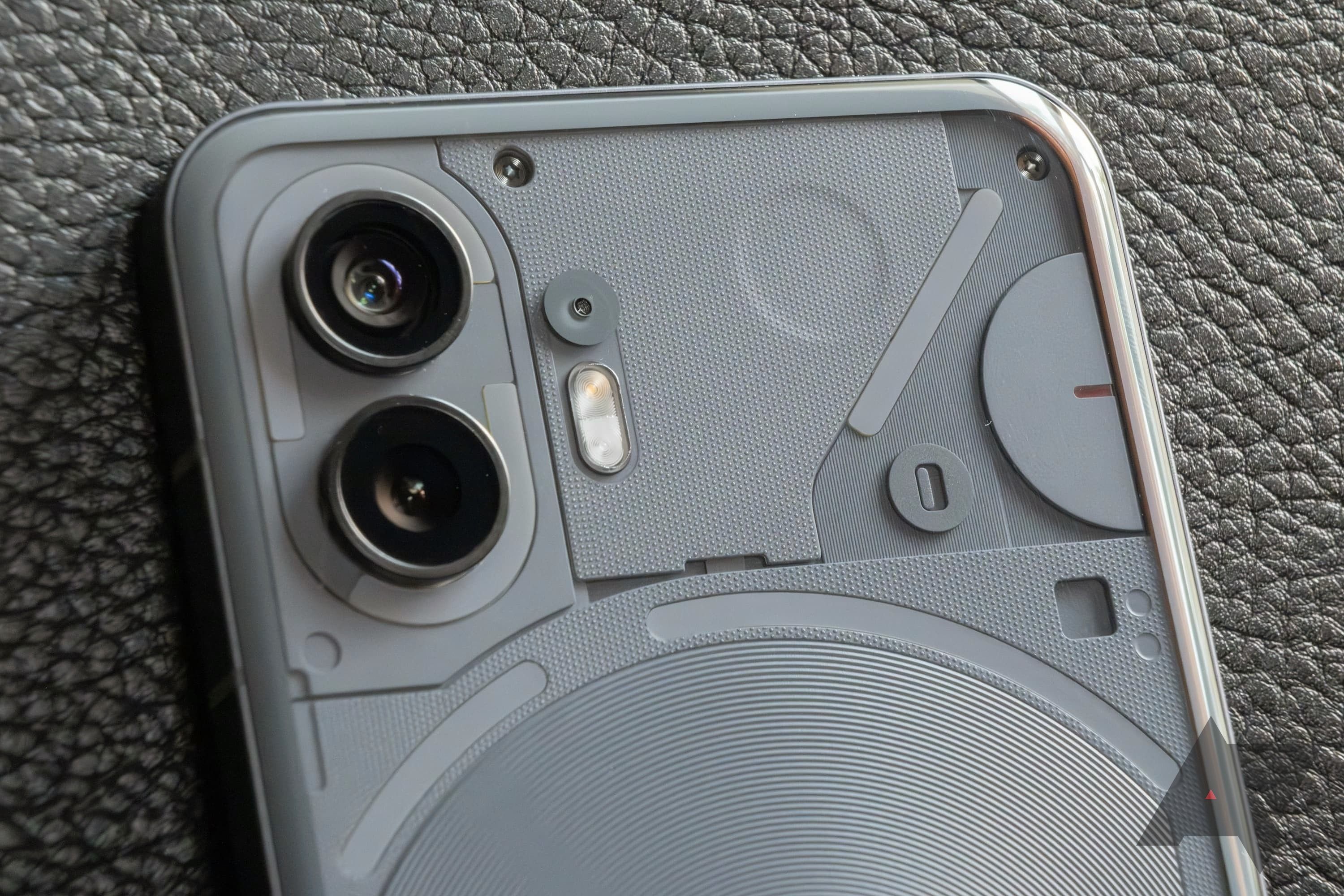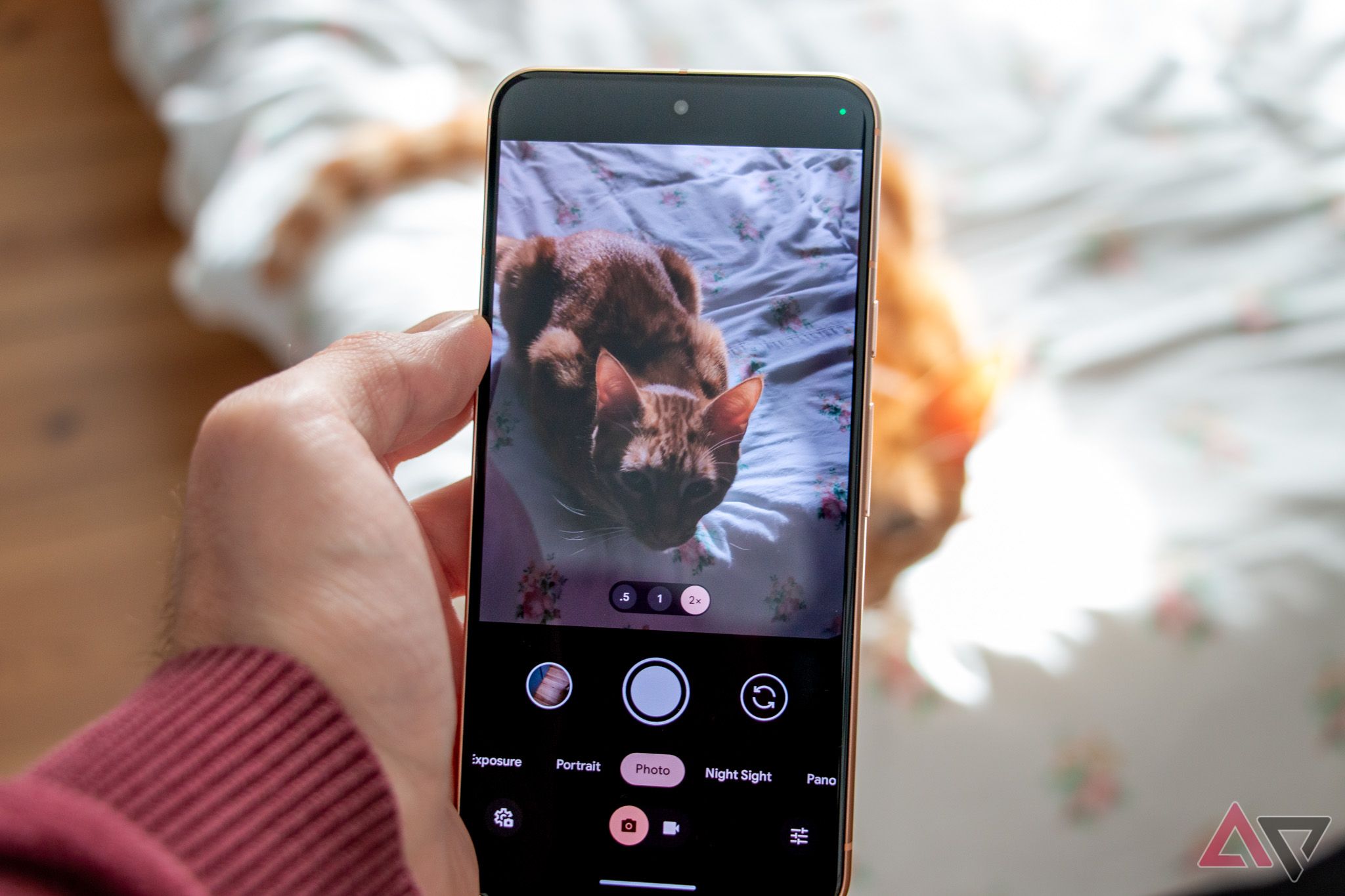-
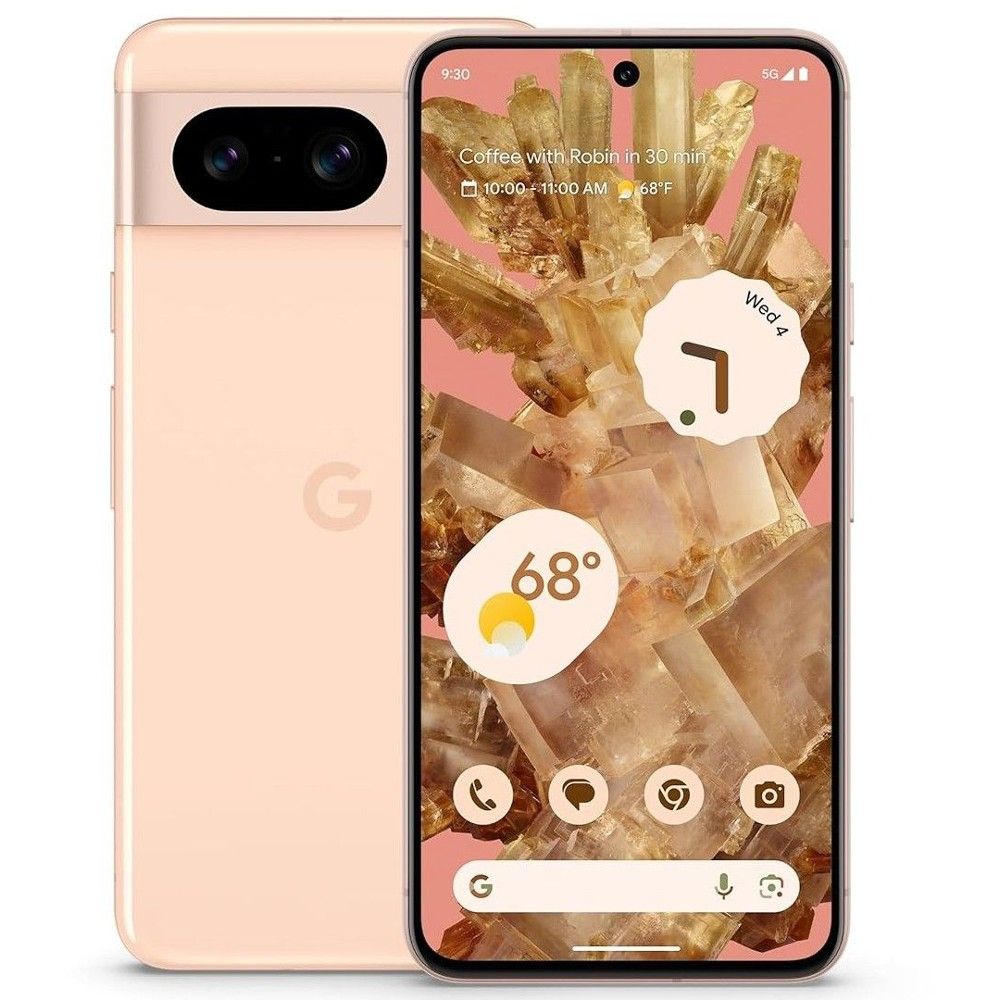
Google Pixel 8
The versatile choice
The Pixel 8’s smaller and ergonomic build might entice those seeking compact phones, a rarity in today’s market. With an impressive commitment to seven years of OS updates, coupled with exceptional AI-based editing tools like Magic Editor, it’s a photography powerhouse that combines reliability with cutting-edge innovation in a perfectly sized package.
Pros- Ergonomic design
- Software goodness
- Better cameras
Cons- Occasional thermal issues
- Slower charging
-
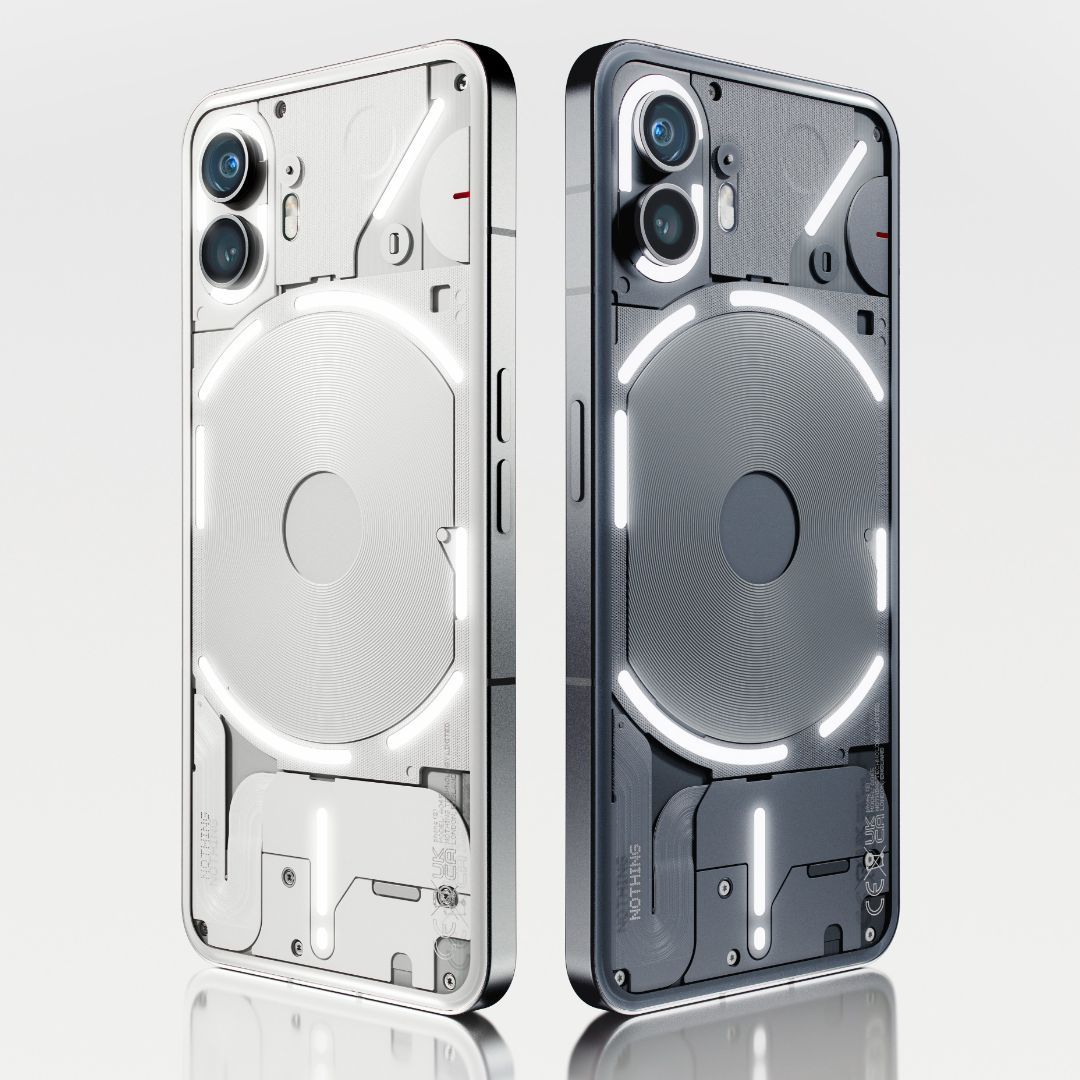
Nothing Phone 2
Charming runner-up
The Nothing Phone 2 epitomizes an aesthetic-focused device, targeting individuals who value unique design and minimalist software. Its standout features include the striking Glyph LEDs and a transparent back, setting it apart visually. While delivering swift performance and impressive charging speeds, it slightly falls short in the camera realm, offering competent yet not flagship-level photography capabilities.
Pros- One-of-its-kind design
- Bigger display
- Faster charging
Cons- Cameras are hit-or-miss
- No IP68 rating
In a tech world dominated by familiar iterations and homogenized experiences, we have two phones carving out their unique identities with exceptional software experiences and distinct design philosophies. The Pixel 8 is Google’s strongest non-pro Pixel yet, immediately cementing its place among the best phones on the market.
Meanwhile, the Nothing Phone 2 exudes a unique aesthetic allure, boasting a refined and minimalist experience that sets it apart. Both promise flagship-caliber features at approachable prices, but the question remains: which of these devices aligns with your preferences and demands?
Price, availability, and specs
The Pixel 8 debuted in October 2023, stepping up its pricing by $100 from its predecessor, now starting at $699 for the base 128GB variant. However, occasional sales have dropped the price to $549, and the 256GB model, originally priced at $799, has been seen selling at $609. The Pixel 8 is widely accessible, retailing across major carriers and Google Store. While compatible with all networks, Verizon customers might incur an additional $100 for the requisite mmWave antenna-equipped version.
Launched in July 2023, the base Nothing Phone 2 with 8GB RAM and 128GB storage is priced at $599, but like the Pixel has dropped below that during sales. The upgraded models with 12GB/256GB and 12GB/512GB configurations are priced at $699 and $799, respectively. Directly purchasable from Nothing and Amazon, it’s certified for use on AT&T and T-Mobile but lacks Verizon certification. While functional on Verizon’s sub-6 5G network, the absence of LTE band 13 limits compatibility with Verizon’s crucial 4G coverage, affecting its suitability for Verizon users.
-
Google Pixel 8 Nothing Phone 2 SoC Google Tensor G3 Qualcomm Snapdragon 8+ Gen 1 RAM 8GB LPDDR5X 8GB, 12GB Storage 128GB, 256GB 128GB, 256GB, 512GB Battery 4,575mAh 4,700mAh Ports USB-C USB-C Operating System Android 14 Android 14 with Nothing OS 2.5 Front camera 10.5MP, f/2.2 32MP, f/2.5 Rear camera 50MP, f/1.7, OIS main; 13MP, f/2.2 ultrawide 50MP, f/1.9 main; 50MP, f/2.2 ultrawide Dimensions 150.5 x 70.8 x 8.9mm 162.1 x 76.4 x 8.6mm Colors Rose, Hazel, Obsidian Black White, Gray Weight 187g 201g Charge speed 27W wired, 18W wireless 45W wired, 15W wireless IP Rating IP68 IP54 Display dimensions 6.2-inch 6.7″ Display resolution 1080 × 2400 1080 x 2412 SIM support Dual SIM (Nano SIM and eSIM) Dual SIM Wi-Fi connectivity Wi-Fi 7 (except certain markets) Wi-Fi 6 Bluetooth Bluetooth 5.3 Bluetooth 5.3 Display type OLED, 120Hz OLED, 120Hz
Design and build
Light it up
Echoing its iconic Pixel lineage, the Pixel 8 refines its appearance with rounded edges and slightly beefed-up cameras within the signature visor-style bar, maintaining that Pixel charm. Yet, it’s not all pixel-perfect; the camera bar’s love for dust and lint remains unchanged, a quirk that’s been tagging along for a while. Slimmer and more pocket-friendly than ever before, the Pixel 8 champions the ‘smaller is better’ ethos, albeit missing the Pro’s fingerprint-resistant frosted back. As for colors, it says goodbye to some old pals (RIP green and white) but welcomes Rose and Hazel to the Pixel family.
The Nothing Phone 2 stays true to its roots too, flaunting its internals through a transparent back, keeping the mesmerizing Glyph LED vibe alive. However, unlike the Pixel, the Nothing Phone 2 has grown compared to its predecessor, making it noticeably bigger and heavier than the Pixel. It’s still available in the Classic White variant, but a Smoky Gray variant replaces the original’s Black finish. While maintaining its captivating Glyph lights, the Phone 2 improves the degree of control within individual zones, albeit sticking to a single color palette.
In the design department, the Pixel 8 scores functional wins with an IP68 rating, offering better defense against dust and water ingress compared to Nothing’s IP54 certification, which protects it only against minor splashes. Additionally, the Pixel 8’s USB-C port boasts swifter data transfer speeds at USB 3.2, blazing ahead of the Nothing Phone’s USB 2.0 offering.
Display
Bright or big?
Google’s Pixel 8 features a 6.2-inch 1080 x 2400 OLED display, which made headlines for its remarkable brightness, peaking at 2,000 nits and boasting 1,400 nits in HDR mode. With its vibrant color gamut, expansive viewing angles, and impressive sunlight legibility, this display sets a high bar among mobile screens. The variable refresh rate, switching from 60Hz to 120Hz, delivers consistently fluid visuals while optimizing battery life when feasible.
On the flip side, the Nothing Phone 2 packs a larger 6.7-inch 120Hz LTPO OLED display, showcasing HDR10+ support and a rich palette of 1 billion colors. With an impressive peak brightness of 1600 nits of its own, it’s excellent for immersive multimedia experiences too, offering a much larger viewing area compared to the Pixel.
Both phones share stereo speakers for an immersive audio experience but omit the 3.5mm headphone jack.
Additionally, both devices utilize an optical under-display fingerprint scanner for secure and convenient unlocking. The Pixel 8 secures another functional win, being one of the select Android devices with the capacity to employ facial authentication securely for sensitive activities like online banking and payments.
Performance and battery
Too close to call
In the engine room, the Pixel 8 runs on the Tensor G3 SoC, Google’s latest proprietary chipset, aiming to address concerns of overheating and battery drain in previous Tensor iterations. The Nothing Phone 2 is powered by the Snapdragon 8+ Gen 1, which is technically a last-year chip but still packs quite a punch. Despite being from different years, benchmark comparisons suggest an equilibrium between the Tensor G3 and Snapdragon 8+ Gen 1 in terms of raw power.
In real-world scenarios, both phones exhibit top-tier performance, deftly handling demanding tasks like photo editing and gaming. Apps launch with remarkable speed, multitasking flows seamlessly, and gaming experiences maintain a consistent smoothness. However, in our testing, the Pixel 8 occasionally showed signs of warming, particularly during taxing activities like high-res video capture and AI-powered editing. Although it didn’t compromise performance, reports of varied user experiences around overheating and battery life under specific connectivity conditions have surfaced, hinting at potential concerns.
The Nothing Phone 2 offers better battery life in comparison, partly due to its larger 4,700mAh battery compared to the Pixel 8’s 4,575mAh cell. Plus, it supports 45W wired charging which can fully replenish the phone in under an hour. However, this high-speed charging requires a PPS-enabled charger. Meanwhile, the Pixel 8 adopts a respectable 27W wired charging speed, taking a more leisurely hour and a half to reach a full battery.
The Pixel 8 offers faster 18W wireless charging, but exclusively via its official Pixel stand, slowing down to 12W on other pads. On the flip side, the Nothing Phone 2 supports a solid 15W for wireless charging. Notably, both phones offer the convenience of wirelessly charging other devices, be it another phone or your TWS earbuds.
Software and user experience
Fun features or software support?
In a sea of standardized software and hardware experiences, these two phones offer a wide range of differences when it comes to the user experience. Starting with the Pixel 8, which comes with Android 14 straight out of the gate and promises an astounding seven-year software support. Google’s software-first approach ensures a bunch of exclusive features tailored for Pixel users. For instance, Google Assistant gets a boost with faster speech processing and the ability to understand pauses and verbal fillers for more natural interactions. Similarly, voice dictation receives a speed upgrade and multilingual input support. Call Assist is refined with better spam filtering and dynamic conversation-based answer suggestions.
The Nothing Phone 2 launched with Android 13 but has already received the Android 14 update with NothingOS 2.5. The software experience largely mirrors Google’s Android, offering a minimally themed UI, and users can opt for stock Android over NothingOS during setup. The interface allows tons of customization, from unique widgets and expanded app icons to monochrome themes, providing an elegant but functional experience.
Nothing promises three years of Android updates (until Android 16) and four years of bi-monthly security patches. The unique feature of Nothing’s phones is the Glyph interface, which remains a focal point here. This feature illuminates LED strips under the rear glass for notifications, now enhanced with support for essential notifications, timer progress bars, and an experimental Uber feature for ride progress. A bit gimmicky? Perhaps. But it’s a unique and fun addition that doesn’t overshadow the phone’s overall functionality, to say the least.
Cameras
Pixel-perfect
Considering the Pixel series’ renowned emphasis on exceptional camera performance, this one’s straightforward.
Let’s get the hardware specs out of the way first. Both phones feature a 50MP primary camera with OIS, but the Pixel 8 boasts a slightly wider f/1.7 aperture compared to the f/1.9 lens on the Nothing Phone 2. Additionally, both phones offer a secondary ultrawide camera. The Pixel houses a 12MP sensor with a 126-degree field of view, while the Nothing Phone 2 showcases a higher resolution 50MP sensor with a narrower 114-degree field of view for its ultrawide lens.
For selfies, the Nothing Phone 2 touts a 32MP front camera compared to the Pixel 8’s 10.5MP, although the Pixel stands out with its ability to shoot 4K selfie videos, while the Nothing Phone 2 is limited to 1080p.
The camera performance of the Nothing Phone 2 holds its ground well in good lighting conditions, churning up good-looking shots that most users can easily live with. However, when faced with more demanding scenarios, such as high-contrast or tricky lighting scenes, the Pixel 8 showcases its software prowess. In such situations, the Pixel’s advanced software algorithms preserve more detail in both highlights and shadows, whereas Nothing’s software processing clearly demonstrates a need for further fine-tuning. Additionally, the Pixel’s responsiveness in capturing moving subjects outperforms the occasional shutter lag observed in the Nothing Phone 2.
Now, let’s dive into the Pixel’s unique features. The Pixel 8 introduces the Magic Editor, an AI-powered tool that redefines post-capture editing. This feature allows for intuitive image recomposition, altering skies, changing hues, and stylizing images with remarkable ease. Despite minor imperfections, the Magic Editor’s ability to achieve such edits within minutes is undeniably impressive.
Google also enhanced its Magic Eraser, refining its capabilities to tackle larger objects and more complex structures. And then there’s Best Take, an intriguing feature that’s arguably pushing the boundaries between reality and altered imagery. Another new addition is the Magic Audio Eraser, which uses machine learning to refine video audio by reducing unwanted noise despite occasional hiccups in the process. All in all, the Pixel 8 offers a much more well-rounded camera experience compared to the Nothing Phone 2.
Google Pixel 8 vs Nothing Phone 2: Which should you buy?
With both phones priced similarly, the Pixel 8 emerges as the victor, offering a comprehensive package that appeals to a broad spectrum of users. Google’s offering stands out for its exceptional software experience, backed by a promise of unparalleled longevity with seven years of full OS updates.
Its prowess in photography, especially in challenging conditions, remains unmatched. Moreover, the addition of the innovative Magic Editor and other AI-driven features make it a dream for creative souls. However, the Pixel 8 does stumble in moments of extended usage, prone to warming up, particularly during resource-intensive tasks.

Google Pixel 8
The versatile champ
Software wizardry at its best
The Pixel 8’s smaller and more ergonomic build might entice those seeking compact phones, a rarity in today’s market. With an impressive commitment to seven years of OS updates, coupled with exceptional AI-based editing tools like Magic Editor, it’s a photography powerhouse that combines reliability with cutting-edge innovation in a perfectly sized package.
On the flip side, the Nothing Phone 2 has its own allure. Its standout aesthetics, minimalist ethos, and unique Glyph interface offer a refreshing departure from the conventional. While its cameras deliver decent shots in good lighting conditions, it trails slightly behind the Pixel 8, struggling in more challenging scenarios and occasional shutter lag.
Ultimately, the Pixel 8 triumphs as the versatile choice, but the Nothing Phone 2 carves a niche for individuals seeking a departure from the mainstream.

Nothing Phone 2
Charming runner-up
Embracing uniqueness
The Nothing Phone 2 epitomizes an aesthetic-focused device, targeting individuals who value unique design and minimalist software. Its standout features include the striking Glyph LEDs and a transparent back, setting it apart visually. While delivering swift performance and impressive charging speeds, it slightly falls short in the camera realm, offering competent yet not flagship-level photography.
Source link
